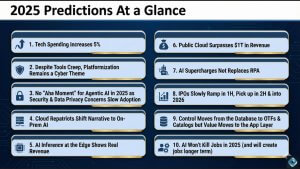As the pace of digital transformation accelerates, application development and networking are increasingly interwoven in their impact on modern enterprises. TheCUBE Research’s latest insights into 2025 trends reveal critical shifts shaping the future of DevOps, networking, and their intersection. Here’s a breakdown of the top predictions and their implications.
AI-Augmented Development Struggles to Scale
In 2025, the allure of replacing human developers with AI-driven systems will face significant resistance. Despite the promise of automating code generation, debugging, and testing, AI tools will remain insufficient for addressing nuanced problem-solving and fostering innovation. For instance, an anticipated high-profile attempt to replace 50% of developers with AI is expected to fail, underscoring the enduring importance of human ingenuity in complex development scenarios. Organizations must balance AI augmentation with the irreplaceable value of human-driven creativity and collaboration.
Unified DevOps Platforms Gain Traction
Complexity reduction will be a driving force in 2025, as 50% of enterprises move away from managing disparate DevOps tools in favor of unified platforms. These platforms streamline workflows, enhance integration, and reduce operational overhead, accelerating application delivery cycles. This consolidation signals a maturing market where operational efficiency and seamless interoperability precede niche tooling.
Spotlight on Developer Productivity
Despite technological advancements, developers will continue to spend only 24% of their time coding. The remaining time will be consumed by designing, testing, debugging, and administrative tasks. Organizations will increasingly turn to automation and AI to address these productivity bottlenecks, enabling developers to focus more on innovation and strategic initiatives. Bridging this gap will be critical for maintaining competitive agility.
The Rise of Secure DevOps Practices
As cyber threats grow in complexity, embedding security into every stage of the software development lifecycle will become non-negotiable. By the end of 2025, over 60% of organizations are expected to implement DevSecOps practices, directly incorporating tools like automated vulnerability scanning, compliance monitoring, and security training into CI/CD pipelines. This shift underscores the necessity of proactive defense mechanisms in a rapidly evolving threat landscape.
Low-Code and No-Code Transformations
The expansion of low-code and no-code platforms by over 30% will democratize application development, empowering citizen developers to take on routine tasks. This shift will elevate professional developers’ roles, pushing them towards governance, advanced customization, and managing complex integrations. This democratization will accelerate innovation cycles while ensuring that technical governance remains robust.
The Integration of Application Development and Networking
Integrating application development with networking reshapes how networks function and deliver services. As applications become more network-sensitive, the traditional role of networks has expanded beyond mere connectivity to include scalability, security, and performance. This evolution is driven by the need for networks to support modern applications heavily reliant on cloud and Internet of Things (IoT) technologies.
Key Impacts of AppDev on Networking:
- Network as Code
The concept of treating the network as code is gaining traction, allowing for agile deployment similar to DevOps practices in application development. This approach enables rapid network configuration changes through software updates, enhancing flexibility and control. - Application-Defined Networking
Advances in software-defined networking have enabled application-defined networking, in which network configurations are tailored to specific application needs to optimize performance and user experience. - Programmable Infrastructure
Programmable infrastructure allows developers to interact with the network through APIs, facilitating innovative solutions that integrate seamlessly with IoT and cloud services. - Enhanced Network Visibility
Tools like Cisco’s AppDynamics provide observability into application performance across networks, helping organizations manage digital services more effectively. - Network APIs for Innovation
Network APIs offer developers access to advanced capabilities such as low latency and enhanced location services, driving innovation in applications that require real-time data processing. - Multicloud Networking
With more businesses adopting multi-cloud strategies, efficient networking solutions like Aviatrix are essential for seamless interconnectivity across diverse cloud platforms. - Networking for AI
AI systems rely heavily on robust networking infrastructure to maximize performance and efficiency, emphasizing the critical role of fine-tuned networks in AI deployments.
The Intersection of Application Development and Networking
The convergence of application development and networking is set to reshape how enterprises deliver and manage digital experiences. As unified DevOps platforms rise, networking teams will play a vital role in ensuring that infrastructure seamlessly supports dynamic application needs. For example, the proliferation of edge computing and microservices architectures demands tight collaboration between developers and network engineers to optimize performance and reliability.
The integration of secure networking principles with DevSecOps practices will further enhance resilience. Automated network security policies and real-time monitoring will align with application workflows, creating a unified approach to development and operations. Networking will no longer be a siloed discipline but an integral part of the application lifecycle.
Closing Thoughts
Our data on theCUBE Research provides insights and predictions for 2025 that paint a compelling picture of an industry at the crossroads of innovation and operational evolution. AI, automation, and unified platforms promise to drive efficiencies, but the human element—creativity, problem-solving, and collaboration—will remain indispensable. As networking and application development converge, enterprises must adopt holistic strategies to stay ahead in this transformative era.
Organizations prepared to embrace these trends will be well-positioned to harness the full potential of technology-driven transformation, paving the way for a more resilient and agile future.
Read more on 2025 predictions in the AppDev space.



